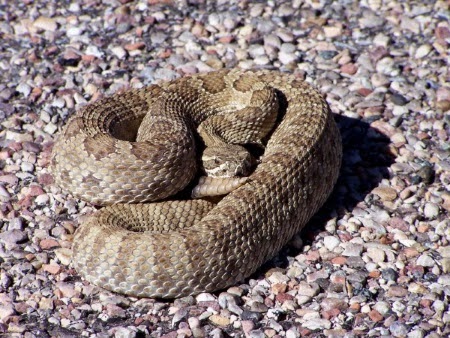Snake Venom, Creation, and Genetics
First up, I want to get some important information out regarding snakes, especially since summer's coming to these here United States, Canada, and the Northern Hemisphere. Don't be thinking you know something about snakes because you watched some movies and television. Some rattlesnakes don't do you the courtesy of coiling up before striking, or even rattling.
Watch your step (got hiking boots?), and don't be groping under rocks, woodpiles, and that sort of thing. If you're out for a hike or a dinosaur dig and you encounter a snake — any snake — leave it alone! The same for if you find one in your shed, garage, or some other place. They don't want to deal with you and usually want to just get away. Freeze, visually locate the critter, and slowly back off, Pilgrim.
Here are some articles on what to do when you encounter them: Dealing With Snakes - Safely Handling Encounters, How to Hike in Rattlesnake Country, and also What to do if you meet a snake on the trail. Although summer is pretty much over in 'Straya, here's something about snakes for you, too. If you don't cotton to cottonmouths or rattlers, maybe consider moving to New Zealand, Ireland, Hawaii, or someplace that doesn't have them. But that drastic measure isn't necessary if you show some sense and respect.
The reason I asked all y'all here is to bring up an article on snake venom. (Certain snakes, lizards, spiders, and whatnot are not poisonous, they're venomous. The difference is how the toxin is delivered. Don't feel badly if you used the wrong word, it's a common mistake.) If creation was perfect at first, why are there venomous snakes? The reason is rather surprising. It's not just a buildup of special genes in the venom gland, since other reptiles (including non-venomous) have some of the same genes. Rather, it's a kind of genetic devolution.
Watch your step (got hiking boots?), and don't be groping under rocks, woodpiles, and that sort of thing. If you're out for a hike or a dinosaur dig and you encounter a snake — any snake — leave it alone! The same for if you find one in your shed, garage, or some other place. They don't want to deal with you and usually want to just get away. Freeze, visually locate the critter, and slowly back off, Pilgrim.
 |
| Image credit: Rattlesnake at Echo Park, Dinosaur National Monument / US National Park Serpents — I mean, Service |
The reason I asked all y'all here is to bring up an article on snake venom. (Certain snakes, lizards, spiders, and whatnot are not poisonous, they're venomous. The difference is how the toxin is delivered. Don't feel badly if you used the wrong word, it's a common mistake.) If creation was perfect at first, why are there venomous snakes? The reason is rather surprising. It's not just a buildup of special genes in the venom gland, since other reptiles (including non-venomous) have some of the same genes. Rather, it's a kind of genetic devolution.
Unbelievers and Christians alike often ask, “How could a good god make creatures with toxic venom?” According to the Bible, God originally created the world free of death, disease, and violence. When Adam and Eve rebelled, the entire creation was subjected to a curse that resulted, among other things, in venomous snakes, stinging arthropods, and disease-causing pathogens.To finish reading, click on "Snake Venom, Genetic Entropy, and Adam's Curse".
A major question facing creation biologists is how this curse has affected the genomes of modern creatures that defy the idea of a perfect creation, such as poisonous snakes. A highly plausible, biblical, and scientific model is now emerging and gaining validity thanks to recent snake studies. This model is based on information corruption in the genome, sometimes referred to as genetic entropy. Support for this idea is based on the fact that genes and their regulatory sequences have become corrupted through genome degradation—resulting in traits inconsistent with the original intent of God’s creation.